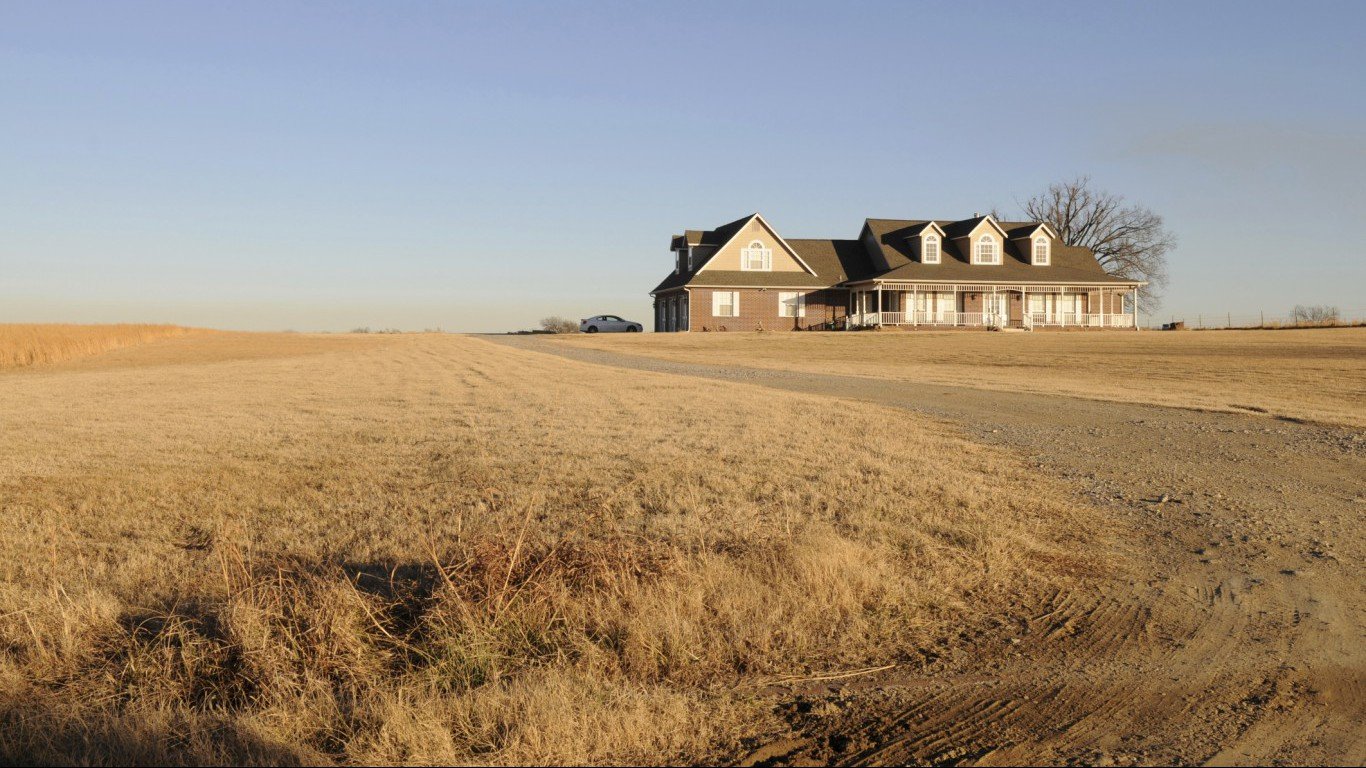Special Report
States With the Longest (and Shortest) Life Expectancy

Published:
Last Updated:

America spent an estimated $9,451 per person on healthcare in 2015, by far the most of any country. However, among wealthy, industrialized nations, the U.S. has the largest share of residents not getting the medical care they need due to financial costs. Among the 35 member nations of the Organization for Economic Co-operation and Development, America is the only country without universal health coverage. This inconsistent coverage and care can create large disparities in health outcomes between populations.
For the first time in decades, life expectancy in the United States fell in 2015. With a life expectancy at birth of 78.8 years, the U.S. ranks 28th among OECD countries. In addition, the U.S. is expected to fall even further behind other countries in the future. By 2030, life expectancy in the U.S. is expected to be on par with the Czech Republic for men and Croatia and Mexico for women.
Poor life expectancy in the U.S. is partially caused by differences in quality of and access to care, as well as a number of socioeconomic conditions that can affect health outcomes. As a result, longevity varies significantly from state to state. Hawaiians have the longest life expectancy, of 81.2 years. By contrast, the life expectancy in Mississippi is only 74.8 years, the shortest of any state. 24/7 Wall St. reviewed the average life expectancy at birth in each of the 50 states.
Click here to see the states with the longest and shortest life expectancy.
Longevity is a complex measure, and the discrepancy between states is due to many factors. Whether a state’s population tends to engage in healthy or unhealthy behaviors is one component.
High rates of smoking, for example, can reduce life expectancy statewide. Smoking is the leading cause of premature death in the U.S., with smokers dying 10 years earlier on average compared to nonsmokers. The 10 states with the shortest life expectancy all have smoking rates higher than the national average. Nine of the 10 states with the longest life expectancy have a lower smoking rate than the nation as a whole.
Following smoking, obesity is the leading cause of premature death. Obese individuals are more likely to have heart disease, stroke, type 2 diabetes, certain types of cancer, and other illnesses. In addition, those who are obese tend to exercise less, which can decrease longevity even further. Leading an active lifestyle has been shown to increase longevity, and states with a high share of sedentary individuals tend to have a lower life expectancy.
Many socioeconomic issues also play a role in a state population’s longevity, and income is one of the most important indicators. Between Mississippi and Hawaii — the states with the shortest and longest life expectancy, respectively — the gap between the typical household income is over $30,000. In addition, the 10 states with the greatest longevity all have household incomes over the national median, and the typical household earns less than the median in all of the 10 states with the shortest life expectancies.
While it has been a historical trend that wealthy individuals live longer than their poorer counterparts, this gap has widened in the past several decades. In 1970, a 50 year old woman in the bottom 10% of earners had a life expectancy of roughly 80.4 years. Women of the same age in the top 10% of earners had a life expectancy of 84.1 years.
In the following two decades, life expectancy for the top earners rose by 6.4 years. During the same period the life expectancy for women in the bottom income bracket didn’t increase at all. Health outcomes lagging behind in the poorest populations partially account for the low life expectancy in the U.S. compared to most other wealthy countries.
To determine the states with the longest and shortest life expectancies, 24/7 Wall St. reviewed 2013 life expectancy at birth figures provided by the Institute for Health Metrics and Evaluation, a global research center affiliated with the University of Washington. Obesity rates and smoking rates were obtained from County Health Rankings & Roadmaps program, a collaboration between the Robert Wood Johnson Foundation and the University of Wisconsin Population Health Institute and are for 2014. Median household income is from the U.S. Census Bureau’s 2015 American Community Survey.
These are the states with the longest and shortest life expectancies.

50. Hawaii
> Life expectancy at birth: 81.2 yrs.
> Obesity rate: 22.1% (2nd lowest)
> Smoking rate: 14.1% (3rd lowest)
> Median household income: $73,486 (2nd highest)
[in-text-ad]

49. California
> Life expectancy at birth: 80.9 yrs.
> Obesity rate: 22.5% (3rd lowest)
> Smoking rate: 12.8% (2nd lowest)
> Median household income: $64,500 (9th highest)

48. Connecticut
> Life expectancy at birth: 80.8 yrs.
> Obesity rate: 24.7% (10th lowest)
> Smoking rate: 15.4% (10th lowest)
> Median household income: $71,346 (5th highest)

47. Minnesota
> Life expectancy at birth: 80.7 yrs.
> Obesity rate: 26.3% (16th lowest)
> Smoking rate: 16.3% (tied-13th lowest)
> Median household income: $63,488 (12th highest)
[in-text-ad-2]

46. Massachusetts
> Life expectancy at birth: 80.7 yrs.
> Obesity rate: 23.7% (6th lowest)
> Smoking rate: 14.7% (7th lowest)
> Median household income: $70,628 (6th highest)

45. New York
> Life expectancy at birth: 80.5 yrs.
> Obesity rate: 24.1% (7th lowest)
> Smoking rate: 14.4% (4th lowest)
> Median household income: $60,850 (15th highest)
[in-text-ad]

44. Colorado
> Life expectancy at birth: 80.3 yrs.
> Obesity rate: 20.1% (the lowest)
> Smoking rate: 15.7% (11th lowest)
> Median household income: $63,909 (11th highest)

43. New Jersey
> Life expectancy at birth: 80.3 yrs.
> Obesity rate: 24.7% (11th lowest)
> Smoking rate: 15.1% (8th lowest)
> Median household income: $72,222 (4th highest)

42. Washington
> Life expectancy at birth: 80.2 yrs.
> Obesity rate: 27.2% (19th lowest)
> Smoking rate: 15.3% (9th lowest)
> Median household income: $64,129 (10th highest)
[in-text-ad-2]

41. New Hampshire
> Life expectancy at birth: 80.1 yrs.
> Obesity rate: 27.3% (20th lowest)
> Smoking rate: 17.5% (23rd lowest)
> Median household income: $70,303 (7th highest)

40. Utah
> Life expectancy at birth: 79.9 yrs.
> Obesity rate: 24.9% (12th lowest)
> Smoking rate: 9.7% (the lowest)
> Median household income: $62,912 (13th highest)
[in-text-ad]

39. Vermont
> Life expectancy at birth: 79.8 yrs.
> Obesity rate: 24.4% (8th lowest)
> Smoking rate: 16.4% (15th lowest)
> Median household income: $56,990 (20th highest)

38. Florida
> Life expectancy at birth: 79.7 yrs.
> Obesity rate: 25.5% (14th lowest)
> Smoking rate: 17.6% (24th lowest)
> Median household income: $49,426 (13th lowest)

37. Rhode Island
> Life expectancy at birth: 79.7 yrs.
> Obesity rate: 26.4% (17th lowest)
> Smoking rate: 16.3% (tied-13th lowest)
> Median household income: $58,073 (19th highest)
[in-text-ad-2]

36. Wisconsin
> Life expectancy at birth: 79.6 yrs.
> Obesity rate: 29.4% (19th highest)
> Smoking rate: 17.4% (tied-21st lowest)
> Median household income: $55,638 (23rd highest)

35. Arizona
> Life expectancy at birth: 79.6 yrs.
> Obesity rate: 23.5% (4th lowest)
> Smoking rate: 16.5% (tied-16th lowest)
> Median household income: $51,492 (20th lowest)
[in-text-ad]

34. Oregon
> Life expectancy at birth: 79.5 yrs.
> Obesity rate: 26.0% (15th lowest)
> Smoking rate: 17.0% (tied-18th lowest)
> Median household income: $54,148 (25th lowest)

33. North Dakota
> Life expectancy at birth: 79.5 yrs.
> Obesity rate: 30.2% (15th highest)
> Smoking rate: 19.9% (tied-14th highest)
> Median household income: $60,557 (16th highest)

32. South Dakota
> Life expectancy at birth: 79.5 yrs.
> Obesity rate: 29.8% (17th highest)
> Smoking rate: 18.6% (24th highest)
> Median household income: $53,017 (23rd lowest)
[in-text-ad-2]

31. Nebraska
> Life expectancy at birth: 79.5 yrs.
> Obesity rate: 29.5% (18th highest)
> Smoking rate: 17.3% (20th lowest)
> Median household income: $54,996 (24th highest)

30. Iowa
> Life expectancy at birth: 79.3 yrs.
> Obesity rate: 30.7% (12th highest)
> Smoking rate: 18.5% (25th highest)
> Median household income: $54,736 (25th highest)
[in-text-ad]

29. Maryland
> Life expectancy at birth: 79.3 yrs.
> Obesity rate: 28.4% (24th highest)
> Smoking rate: 14.6% (6th lowest)
> Median household income: $75,847 (the highest)

28. Idaho
> Life expectancy at birth: 79.2 yrs.
> Obesity rate: 27.7% (23rd lowest)
> Smoking rate: 15.9% (12th lowest)
> Median household income: $48,275 (11th lowest)

27. Illinois
> Life expectancy at birth: 79.2 yrs.
> Obesity rate: 27.4% (22nd lowest)
> Smoking rate: 16.5% (tied-16th lowest)
> Median household income: $59,588 (18th highest)
[in-text-ad-2]

26. Maine
> Life expectancy at birth: 79.1 yrs.
> Obesity rate: 27.9% (24th lowest)
> Smoking rate: 19.3% (21st highest)
> Median household income: $51,494 (21st lowest)

25. Virginia
> Life expectancy at birth: 79.1 yrs.
> Obesity rate: 27.3% (21st lowest)
> Smoking rate: 19.5% (tied-19th highest)
> Median household income: $66,262 (8th highest)
[in-text-ad]

24. Delaware
> Life expectancy at birth: 78.8 yrs.
> Obesity rate: 29.0% (22nd highest)
> Smoking rate: 19.9% (tied-14th highest)
> Median household income: $61,255 (14th highest)

23. Alaska
> Life expectancy at birth: 78.8 yrs.
> Obesity rate: 28.4% (25th highest)
> Smoking rate: 19.9% (tied-14th highest)
> Median household income: $73,355 (3rd highest)

22. Montana
> Life expectancy at birth: 78.8 yrs.
> Obesity rate: 24.6% (9th lowest)
> Smoking rate: 19.9% (tied-14th highest)
> Median household income: $49,509 (14th lowest)
[in-text-ad-2]

21. Pennsylvania
> Life expectancy at birth: 78.6 yrs.
> Obesity rate: 28.8% (23rd highest)
> Smoking rate: 19.9% (tied-14th highest)
> Median household income: $55,702 (21st highest)

20. Texas
> Life expectancy at birth: 78.6 yrs.
> Obesity rate: 28.4% (25th lowest)
> Smoking rate: 14.5% (5th lowest)
> Median household income: $55,653 (22nd highest)
[in-text-ad]

19. Kansas
> Life expectancy at birth: 78.6 yrs.
> Obesity rate: 30.2% (16th highest)
> Smoking rate: 18.1% (25th lowest)
> Median household income: $53,906 (24th lowest)

18. Wyoming
> Life expectancy at birth: 78.5 yrs.
> Obesity rate: 26.6% (18th lowest)
> Smoking rate: 19.5% (tied-19th highest)
> Median household income: $60,214 (17th highest)

17. Nevada
> Life expectancy at birth: 78.2 yrs.
> Obesity rate: 25.4% (13th lowest)
> Smoking rate: 17.0% (tied-18th lowest)
> Median household income: $52,431 (22nd lowest)
[in-text-ad-2]

16. New Mexico
> Life expectancy at birth: 78.2 yrs.
> Obesity rate: 23.6% (5th lowest)
> Smoking rate: 19.1% (tied-22nd highest)
> Median household income: $45,382 (6th lowest)

15. Michigan
> Life expectancy at birth: 78.1 yrs.
> Obesity rate: 31.4% (10th highest)
> Smoking rate: 21.2% (9th highest)
> Median household income: $51,084 (18th lowest)
[in-text-ad]
14. North Carolina
> Life expectancy at birth: 77.9 yrs.
> Obesity rate: 29.1% (20th highest)
> Smoking rate: 19.1% (tied-22nd highest)
> Median household income: $47,830 (10th lowest)

13. Ohio
> Life expectancy at birth: 77.6 yrs.
> Obesity rate: 30.5% (14th highest)
> Smoking rate: 21.0% (12th highest)
> Median household income: $51,075 (17th lowest)

12. Missouri
> Life expectancy at birth: 77.6 yrs.
> Obesity rate: 30.6% (13th highest)
> Smoking rate: 20.6% (13th highest)
> Median household income: $50,238 (15th lowest)
[in-text-ad-2]

11. Georgia
> Life expectancy at birth: 77.5 yrs.
> Obesity rate: 29.0% (21st highest)
> Smoking rate: 17.4% (tied-21st lowest)
> Median household income: $51,244 (19th lowest)

10. Indiana
> Life expectancy at birth: 77.3 yrs.
> Obesity rate: 31.4% (11th highest)
> Smoking rate: 22.9% (7th highest)
> Median household income: $50,532 (16th lowest)
[in-text-ad]

9. South Carolina
> Life expectancy at birth: 76.9 yrs.
> Obesity rate: 31.6% (9th highest)
> Smoking rate: 21.5% (8th highest)
> Median household income: $47,238 (8th lowest)

8. Tennessee
> Life expectancy at birth: 76.4 yrs.
> Obesity rate: 32.2% (8th highest)
> Smoking rate: 24.2% (4th highest)
> Median household income: $47,275 (9th lowest)

7. Arkansas
> Life expectancy at birth: 75.8 yrs.
> Obesity rate: 33.3% (5th highest)
> Smoking rate: 24.7% (3rd highest)
> Median household income: $41,995 (2nd lowest)
[in-text-ad-2]

6. Kentucky
> Life expectancy at birth: 75.8 yrs.
> Obesity rate: 32.3% (7th highest)
> Smoking rate: 26.2% (2nd highest)
> Median household income: $45,215 (5th lowest)

5. Oklahoma
> Life expectancy at birth: 75.8 yrs.
> Obesity rate: 32.4% (6th highest)
> Smoking rate: 21.1% (tied-10th highest)
> Median household income: $48,568 (12th lowest)
[in-text-ad]

4. Louisiana
> Life expectancy at birth: 75.8 yrs.
> Obesity rate: 34.3% (2nd highest)
> Smoking rate: 24.0% (5th highest)
> Median household income: $45,727 (7th lowest)

3. West Virginia
> Life expectancy at birth: 75.4 yrs.
> Obesity rate: 34.1% (3rd highest)
> Smoking rate: 26.7% (the highest)
> Median household income: $42,019 (3rd lowest)

2. Alabama
> Life expectancy at birth: 75.4 yrs.
> Obesity rate: 33.6% (4th highest)
> Smoking rate: 21.1% (tied-10th highest)
> Median household income: $44,765 (4th lowest)
[in-text-ad-2]

1. Mississippi
> Life expectancy at birth: 74.8 yrs.
> Obesity rate: 35.3% (the highest)
> Smoking rate: 23.0% (6th highest)
> Median household income: $40,593 (the lowest)
Ever wanted an extra set of eyes on an investment you’re considering? Now you can speak with up to 3 financial experts in your area for FREE. By simply
clicking here you can begin to match with financial professionals who can help guide you through the financial decisions you’re making. And the best part? The first conversation with them is free.
Click here to match with up to 3 financial pros who would be excited to help you make financial decisions.
Thank you for reading! Have some feedback for us?
Contact the 24/7 Wall St. editorial team.